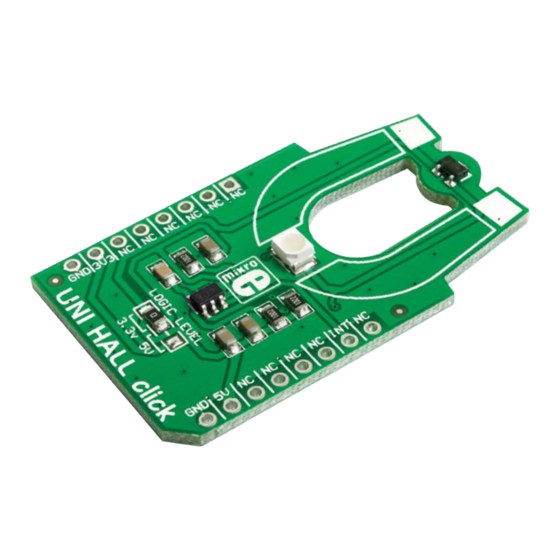
Advertisement
Quick Links
UNI HALL
click
™
1. Introduction
UNI HALL click
is a simple solution
™
for adding an unipolar Hall switch to
your design. It carries the Melexis
US5881 unipolar Hall-effect switch and
a 74LVC1T45 single bit, dual supply
translating transceiver. UNI HALL click
communicates with the target board
through the mikroBUS
INT line. The
™
board is designed to use either a 3.3V or
5V power supply (which also defines the
logic level of the output signal).
2. Soldering the headers
Before using your click
board, make sure
™
to solder 1x8 male headers to both left
and right side of the board. Two 1x8 male
headers are included with the board in
the package.
2
Turn the board upside down so that
the bottom side is facing you upwards.
Place shorter pins of the header into the
appropriate soldering pads.
™
1
3
Turn the board upward again. Make sure
to align the headers so that they are
perpendicular to the board, then solder
the pins carefully.
3. Plugging the board in
Once you have soldered the headers your
board is ready to be placed into the desired
mikroBUS
™
socket. Make sure to align the
cut in the lower-right part of the board with
the markings on the silkscreen at the
mikroBUS
socket. If all the pins
™
are aligned correctly, push the
board all the way into the socket.
4. Essential features
The unipolar Hall effect sensor on UNI HALL
click
is sensitive to north pole magnetic
™
fields—when exposed to such a field, it
outputs a LOW logic level. Othewise the
output is a HIGH logic level. In its simplest
application, UNI HALL click
can be employed
™
as part of a long lasting contactless
proximity switch. However, magnets can
be employed in various ways to infer the
speed, position, or other properties of an
object; there are countless ways to utilize
UNI HALL click
in your design.
™
click
™
BOARD
www.mikroe.com
UNI HALL click
™
manual
ver. 1.00
0 100000 026939
Advertisement

Subscribe to Our Youtube Channel
Summary of Contents for mikroElektronika UNI HALL click
- Page 1 US5881 unipolar Hall-effect switch and Once you have soldered the headers your BOARD a 74LVC1T45 single bit, dual supply board is ready to be placed into the desired translating transceiver. UNI HALL click ™ mikroBUS ™ socket. Make sure to align the www.mikroe.com...
- Page 2 MikroElektronika assumes no responsibility or liability for any errors or inaccuracies that may appear in the present document. Specification and information contained in the present schematic are subject to change at any time without notice. Copyright © 2014 MikroElektronika. All rights reserved.


Need help?
Do you have a question about the UNI HALL click and is the answer not in the manual?
Questions and answers